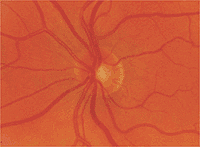Disk variability makes manual diagnosis, assessment hard
Stereopsis is key to disk assessment in glaucoma cases. The best techniques should combine good magnification and stereopsis, physician says.
 ---Normal cup in a large disk. The cup is large because the disk itself is large.
---Normal cup in a large disk. The cup is large because the disk itself is large.
ORLANDO, Fla. — Assessing the optic disk to diagnose glaucoma is a very different task from monitoring a diagnosed case for progression, according to Marcelo Nicolela, MD.
“In glaucoma, we have the luxury of being able to see the affected tissue directly, and yet our ability to detect the disease is poor,” Dr. Nicolela said here at the American Academy of Ophthalmology meeting. Dr. Nicolela cited data from the Baltimore Eye Survey, which found that disk assessment performed almost as badly as intraocular pressure (IOP) measurement as a screening tool for glaucoma. He believes the reason for this is that “huge variability of normal optic disks impairs our ability to detect abnormalities.”
Dr. Nicolela noted that a patient with a very large disk and correspondingly large — but normal — cup (Figure 1) may look more suspicious on disk assessment than one with a small disk with overall enlargement of the cup that is actually glaucomatous (Figure 2).
“Since the optic disk is a very small structure,” he said, “the information about its dimensional shape is very important. The best techniques should combine good magnification and stereopsis.” He said the best tools currently are slit lamp examination in combination with contact or noncontact lenses.
Disk size
 ---This cup, though glaucomatous, appears less suspicious.
---This cup, though glaucomatous, appears less suspicious.
“One of the most important steps in optic disk examination is measuring disk size,” Dr. Nicolela said. “One way is to compare the size of the light from the direct ophthalmoscope projected on the retina with the disk size.” Dr. Nicolela said that for refractive error from +7 D to –7 D, the effect of refractive error on the size of the projected light circle is not significant.
He emphasized the importance of stereo photography of the disk for monitoring progression. He said he also has had great success using the Heidelberg Retina Tomograph (Heidelberg Engineering, Carlsbad, Calif.) to measure the size of the disk. “Our data suggests that it is more sensitive than our perimetry,” he said.
Dr. Nicolela reviewed two types of glaucomatous damage. He reported that he and colleagues have evidence that different disk characteristics may represent groups of patients with specific disease characteristics. One such group is represented by the disk with very localized loss in the neuroretinal rim, that is, focal glaucoma.
“This type of disk damage is three times more likely in females, and they often have signs of vasospastic disorders, such as migraine or other vascular disease,” Dr. Nicolela said. “The IOP in these patients is frequently normal or slightly elevated, and they have repeated disk hemorrhages.” Damage frequently starts in the inferior pole, causing a very dense superior visual field defect.
A second type is the group of patients with progressive generalized or concentric increase in the cup. These are generally relatively young patients who have markedly elevated IOPs and rarely develop disk hemorrhages. Their visual field abnormalities are usually more diffuse.
These two types appear to be different conditions but are both currently included under the umbrella term “primary glaucoma,” Dr. Nicolela said.
He concluded by reinforcing the importance of stereoscopic disk examination. “Careful assessment of the disk is probably still the best way of diagnosing early glaucoma,” he said. “Optic disk photography is important to detect progression, but newer automated techniques may prove to be valuable.”
For Your Information:Reference:
- Marcelo Nicolela, MD, can be reached at (902) 473-3605; fax: (902) 473-2839; e-mail: nicolela@is.dal.ca. Dr. Nicolela did not participate in the preparation of this article.
- For information on the Heidelberg Engineering Retina Tomograph, contact John A. Hawley, vice president, Heidelberg Engineering Inc., 5661 Palmer Way, Ste. G, Carlsbad, CA 92008; (760) 930-3570; fax: (760) 930-3575; Web site: www.Heidelbergengineering.com.
- Tielsch JM, Katz J, Singh K, et al. A population-based evaluation of glaucoma screening: the Baltimore Eye Survey. Am J Epidemiol. 1991;134(10):1102-1110.
